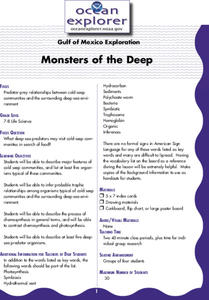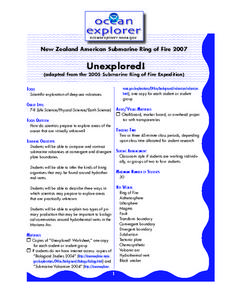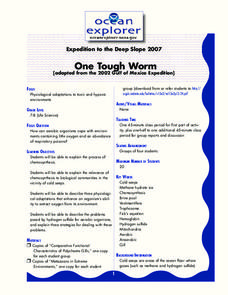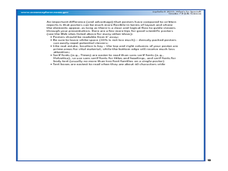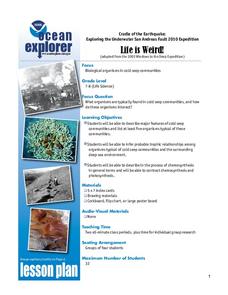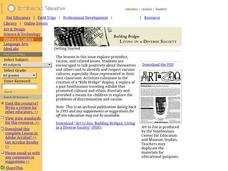Curated OER
It's a Gas! Or is it?
Young scholars describe the effects of temperature and pressure on solubility of gases and other materials. In this investigative lesson students read an article and answer questions about it.
Curated OER
Monsters of the Deep
Students describe major features of cold seep communities, and list at least five organisms typical of these communities. They infer probable trophic relationships among organisms typical of cold-seep communities.
Curated OER
Who Has the Light?
Students study ways in which the ability to produce light may be useful to deep-sea organisms. In groups, they research and present to the rest of the class, how a specific organism is able to produce bioluminescence.
Curated OER
Unexplored!
Students explore volcanoes. In this deep sea volcano activity students complete a worksheet and various activities.
Curated OER
Monsters of the Deep
Students describe major features of cold seep communities and list the organisms that are typical in these communities. For this deep sea environment lesson students work in groups and research their given cold seep group.
Curated OER
One Tough Worm
Learners explain the process of chemosynthesis and its relevance to biological communities. In this investigative lesson plan students discuss chemosynthetic communities, then in groups they are assigned a species and are to calculate...
Curated OER
Treasures in Jeopardy
Learners compare and contrast deep sea coral reefs to shallow water reefs. In this coral reef lesson students develop a poster that could be used to educate the public about the importance of coral reefs.
Curated OER
Let's Go to the Video Tape!
Young scholars examine biological diversity and see how it relates to the concepts of variety and relative abundance. In this investigative lesson students view a video on biodiversity and complete an activity.
Curated OER
Sedimentary Size and Structures
Middle schoolers interpret the Earth's history from models. In this investigative lesson plan students create sedimentary deposit models.
Curated OER
Let's Hit the Slopes!
Students study benthic communities in the Gulf of Mexico and explain their roles. In this investigative lesson students participate in a group activity and study how to calculate and index of biological communities.
Curated OER
What's So Special?
Students study the biology and morphology of Lophelia corals. In this investigative lesson students explain how the coral contributes to communities, and create a poster.
Curated OER
Life is Weird
Young scholars describe features of cold seep communities and investigate five organisms that live there. In this biological organisms lesson students research a given species and give an oral presentation on their results.
Curated OER
Life is Weird
Students study the organisms that are found in cold seeps and see how they interact with each-other. In this biological organism lesson students describe the major features of cold seeps and the process of chemosynthesis.
Curated OER
Life is Weird
Learners describe features of cold seep communities and list organisms that can be found in these communities. In this exploratory lesson plan students complete an activity and describe the process of chemosynthesis.
Curated OER
The Oceanographic Yo-Yo
Students examine how oceanographers use chemical and physical parameters of seawater to locate hydrothermal vents. In this ocean lesson plan students complete an activity and worksheets.
Curated OER
Sonar Simulation
Students explore how a side-scan sonar can help locate underwater objects. In this hands- on lesson students compare side-scan sonar and other methods used to search for underwater objects by creating their own "simulation" of a...
Curated OER
Communication Skills for Seeking a Job
Students discuss and identify four careers they have an interest in. Using the internet, they choose one career to research to discover the educational requirements, salary and training. They interview members of the community in the...
Curated OER
Food Web Mystery
Students describe typical marine food webs, and explain why food is generally scarce in the deep-ocean environment. They discuss reasons that seamounts may support a higher density of biological organisms than would appear to be possible.
Curated OER
How Does Your Magma Grow?
Students identify the three types of plate boundaries and the Earth's tectonic plates system. They examine how the Galapagos Islands were formed and hydrothermal vents.
Curated OER
Big Fleas Have Little Fleas!
Students study seamounts and learn the importance of structures to species. In this ocean explorer lesson, students participate in an activity that teaches them how to modify a seamount so that they are more suitable for species.
Curated OER
Whole Lotta Shakin Going On
High schoolers study how tectonic plates can produce earthquakes. In this earthquake lesson students use a model earthquake machine to explore hypotheses about earthquakes.
Curated OER
Distant Relatives
Students investigate observations between widely separated populations of anchialine cave fauna. In this biogeography lesson students discuss theories that could explain the given observations.
Curated OER
Your Expedition of Discovery
Students study GPS and see how it is used to determine points on the Earths surface. In this expedition lesson plan students use GPS to find given coordinates.
Curated OER
Building Bridges: Living in a Diverse Society
Students participate in various activities that help them build esteem, and explore racism. In this multicultural lesson plan, Students increase their awareness of, and appreciation for, cultural differences and similarities. This...



